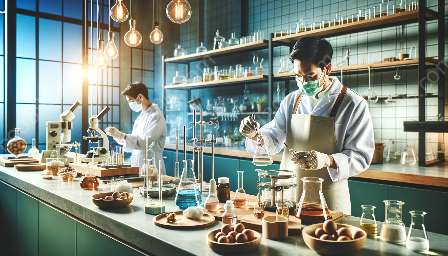When you step into the kitchen to cook or bake, you're not just creating delicious food - you're also engaging in a series of complex chemical reactions. Understanding the science behind these transformations can help you become a better chef, whether you're a home cook or a professional in the culinary industry.
In this topic cluster, we'll explore the relationship between chemical changes, food chemistry, and culinology by delving into the various processes and reactions that occur during cooking and baking.
The Fundamentals of Chemical Changes in Cooking and Baking
Chemical changes during cooking and baking are fundamental to the transformation of raw ingredients into flavorful, aromatic dishes. These changes are influenced by a myriad of factors, including heat, moisture, pH levels, and the interaction of different compounds.
Food chemistry plays a crucial role in understanding these transformations. It involves the study of the chemical processes and interactions that occur in food materials, as well as the application of this knowledge to improve the quality, safety, and nutritional value of food products.
Culinology, on the other hand, combines the principles of culinary arts and food science to create innovative, appealing, and nutritious food products. By integrating the science of food chemistry into culinary practices, culinologists can optimize flavors, textures, and overall food quality.
The Influence of Heat on Chemical Changes
One of the most significant factors in chemical changes during cooking and baking is heat. When food is subjected to heat, various chemical reactions take place, leading to the development of complex flavors and textures.
One well-known chemical reaction that occurs during cooking is the Maillard reaction. This reaction occurs when sugars and amino acids in food are subjected to heat, resulting in the browning of the food and the formation of desirable flavors and aromas. Understanding the Maillard reaction is crucial for chefs and culinologists, as it can help them achieve the desired taste and appearance of their dishes.
Furthermore, heat can also cause changes in proteins, leading to denaturation and coagulation. These processes affect the texture and structure of food, influencing its palatability and mouthfeel.
The Role of Moisture in Cooking and Baking
Moisture is another essential element in the chemical changes that occur during cooking and baking. The presence of moisture affects the gelatinization of starches, the caramelization of sugars, and the emulsification of fats, all of which contribute to the overall sensory characteristics of food.
Understanding the interactions between moisture and food components is a key aspect of food chemistry. By controlling the moisture content and its distribution within the food matrix, chefs and culinologists can manipulate the texture, juiciness, and tenderness of their culinary creations.
pH Levels and Chemical Reactions
The pH levels of ingredients also play a crucial role in determining the outcomes of cooking and baking. Acidic and alkaline ingredients can influence the rate and extent of chemical reactions, leading to changes in color, flavor, and texture.
For example, the leavening agents used in baking, such as baking soda and baking powder, react with acidic components to produce carbon dioxide gas, which helps in the leavening and rising of baked goods. Understanding the pH-dependent reactions is essential for achieving the desired characteristics in various food products.
Culinary Innovations Through Understanding Chemical Changes
By integrating the principles of food chemistry and culinology, chefs and food scientists can create innovative culinary creations. These innovations may involve the development of new cooking techniques, the use of specialized ingredients, or the application of advanced food processing technologies.
Understanding the chemical changes that occur during cooking and baking empowers culinary professionals to harness the full potential of raw ingredients, creating dishes that are not only delicious but also visually appealing, nutritious, and safe for consumption.
Conclusion
Chemical changes during cooking and baking are intricate processes that significantly impact the sensory and nutritional properties of food. By embracing the principles of food chemistry and culinology, culinary professionals can elevate their skills and create extraordinary culinary experiences for their customers and audiences.


